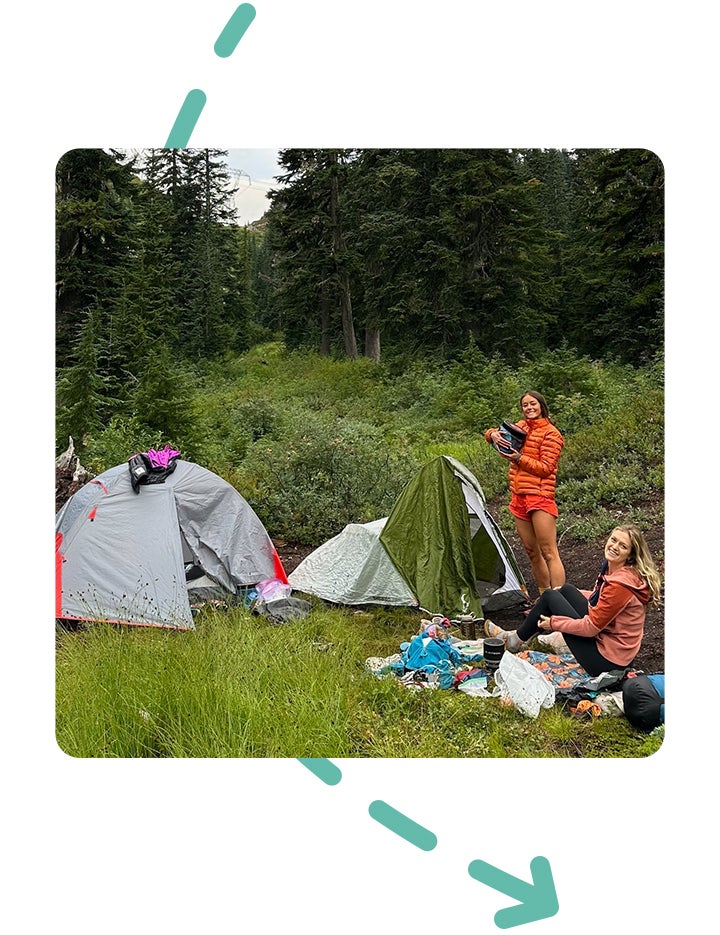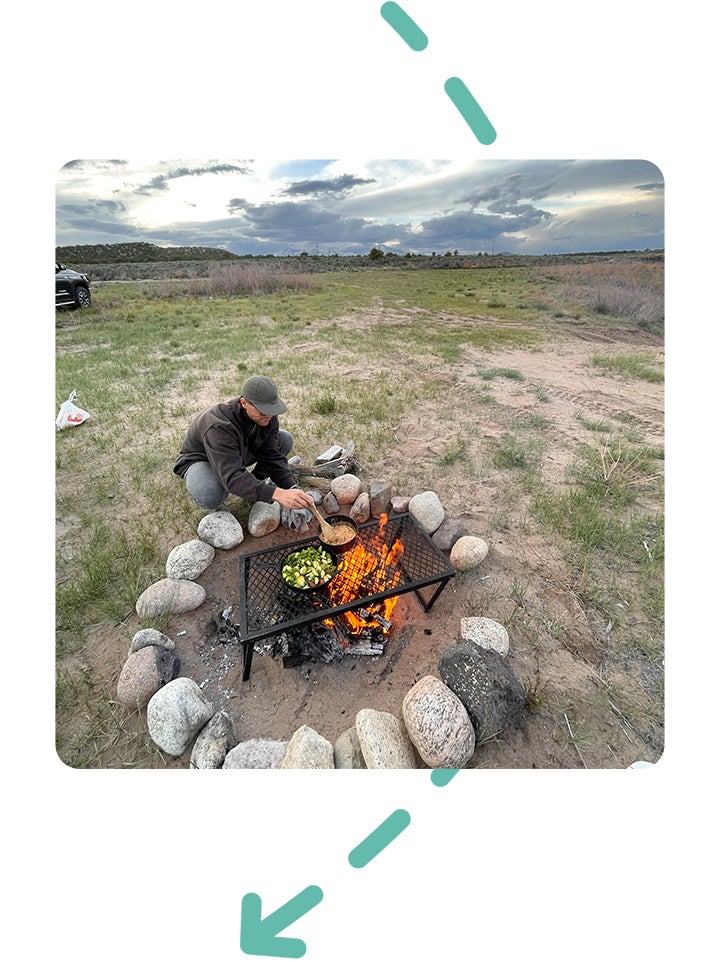Picture this: you hear birds chirping, smell the earthy scent of pine or oak and feel the sun on your skin before you’ve even opened your eyes for the morning. The camping trip you put together on an affordable budget has finally come to fruition.
Not everyone can afford an international trip or cross-country flight this year. Bankrate’s 2025 Summer Travel Survey reports that, among Americans who aren’t traveling this summer, nearly 2 in 3 (65 percent) say they can’t afford to.
Even if a luxury vacation isn’t in the cards, a camping adventure might be. The costs can be lower, and your schedule is more flexible. One in 10 Americans (10 percent) are planning a staycation this summer, so perhaps your “getaway” is just an adventure under the stars in your own backyard.
“Camping is such a great option when you are not looking to spend lots of money and you’re not really sure what your future is going to hold or what the economy is going to do,” says Sameer Dohadwala, head of global operations at Hipcamp, an online booking site for camping, glamping and more.
People are reconnecting with nature, getting back outside.
— Sameer Dohadwala, head of global operations at Hipcamp
As someone who camped more than 10 times last year — without going into travel debt — I have some tips for an affordable, fun and safe experience.
Come with me for one of my favorite types of travel.
Reserve campsites
The first thing I do when planning a camping trip is figure out where I’ll sleep.
You have a few options. A straightforward way to secure a campsite and have access to amenities — like tap water, a bathroom and a shower — is to explore state and national parks. Depending on whether you’re staying local or planning a road trip, look for nearby national parks on NPS.gov or the website of the state you’re visiting. I live in Colorado, so I often use Colorado Parks & Wildlife’s state park finder.
While you’re at it, it’s not a bad idea to buy a park pass. An annual national park pass is $80, and the most popular parks charge up to a $35 daily vehicle entrance fee. If you plan to visit any national parks more than two days a year, the pass is worth it. Same goes for state park passes.
If you want to get off the beaten path, you can also scope out private campsites, RV parks or dispersed camping (“boondocking”). My boyfriend and I often opt for dispersed spots — where you can legally camp wherever you choose, with no amenities — because they’re free and far less crowded. The Dyrt is a great resource for finding dispersed sites in your area.
Dohadwala, of course, also recommends Hipcamp, which is “deeply, deeply committed to helping people spend more time outside, connect with nature.”
Personally, I’ve camped on Hipcamps with riverfront access, goat herds and proximity to national parks.
Choose your camping setup
The campsite I choose determines the type of camping setup I’ll bring. For backpacking or walk-in sites, I tent camp. For sites you can park at, we usually car camp.

Your camping layout can range from modest to luxurious. My parents love their pop-up camper, which can run from $5,000 resale to $20,000 or more for a new model. New RVs can cost more than $100,000. And camper vans — which are all the rage — can cost thousands of dollars to renovate or tens of thousands to buy already built out.
Still, RVTrader.com estimates that renting an RV for a family vacation, one of the more expensive ways to camp, costs 30 to 40 percent less than a flight-and-hotel vacation.
And you don’t have to box yourself into just one type of accommodation.
“We see people who go on a trip with their families, so maybe they want a more commercial campground with lots of amenities and a pool,” Dohadwala says.
He continues: “And then they’re going with their friends, and they just want some secluded area where they have 500 acres to themselves. And then sometimes they’re doing a road trip, and they just want to have some stops off with their RV.”
Whatever you choose, it’s worth investing in a quality setup that will keep you warm, dry and comfortable. Tent campers might enjoy an inflatable or collapsible sleeping pad. Car campers can install bedding, a truck bed topper or even a rooftop tent. And of course, camper vehicles or trailers are cozy, but beware — they’re prone to breakdowns. It helps to travel with tools and a basic knowledge of your vehicle’s maintenance.
I got really into tent camping, and it was because I had friends who were really into tent camping. They introduced me by going out to these really secluded Hipcamps and other campgrounds.
— Sameer Dohadwala
Head of global operations at Hipcamp
Plan your meals
Just like in daily life, it’s more affordable to cook your meals while camping than to dine at nearby restaurants or camp stores. By planning ahead and bringing groceries, you can save on your travel budget.
Contrary to popular belief, you don’t have to survive on ramen or peanut butter from the jar. I use recipes tailored for camping, like these from Jetboil and Solo Stove, and buy and prep ingredients before I go.
It helps to pick one cooking method to plan around. I use my Jetboil — a small stove — to boil water for coffee and freeze-dried meals or warm up pre-prepared food. My boyfriend prefers cooking over a campfire with a portable grate and skillet. If you’re in a camper vehicle, you might even have a cooktop stove to work with.

Scout out activities
For many types of vacations, activities are a significant chunk of the budget — paying for tours, museum admissions, shows, tastings, shopping, spa treatments and more. Don’t get me wrong, I like these things too! But for budget travelers, you might find that camping is the activity.

Driving somewhere beautiful, setting up camp and cooking is part of the fun. And if the goal is to be outdoors, many of those activities are free — hiking, swimming, kayaking, biking, watching wildlife, stargazing and reading in a hammock, to name a few.
The key is to have ideas before you go so you’re not sitting in your tent, twiddling your thumbs. Research the best outdoor activities where you’re headed. Pack a book that’s been on your list. Bring cards or lawn games to play with your camping buddy.
It takes a little creativity to fill your time, but you might be surprised how much free fun there is to be found.
Calculate your savings
The average cost of a vacation in 2025 is more than $7,000, including transportation, accommodations, food and entertainment. While camping isn’t free, it can be a more affordable alternative.
Sarah Gage, Bankrate managing editor, is a seasoned camper who creates budget-friendly travel experiences with her son.
“We’ve made so many memories and started so many of our own traditions on different trips,” she says. “I’m grateful to get to have this time with him now while he’s still young.”

Here are a few ways a camping trip can trim your travel budget.
- Flights: Many camping trips are accessible by car, or even required if it’s part of your camping setup. I’ve flown to camp in other destinations a few times, but it’s rare. You can save between $273 and $473 on the average airline ticket by driving.
- Car rentals: When you fly to a destination, you might be renting a car unless it’s an easily walkable area. But again, if you’re driving, your main cost will be for gas or EV charging. And gas prices today are 8.3 percent cheaper than they were a year ago.
- Lodging: While campsites aren’t always free, they’re still more affordable than the average $237 hotel room stay. The exception is if you have a hotel credit card and tend to book stays with points. Gage points out that state park and resort campsites in Michigan, where they live, can cost $50 or more per night. “Since I book most hotels with points, that’s actually a higher lodging cost for me,” she says. But Dohadwala points out that Hipcamp offers tent sides as affordable as less than $10 a night. You can also book glamping, like yurts and bell tents, that have all the bells and whistles for a lower price than a hotel room.
- Dining: Trying new restaurants isn’t usually the focal point of a camping trip, like it is when visiting a new city or country — which could save you an average of $96 per day. Just consider you’ll probably have to make a grocery run beforehand, and Gage notes there’s no free hotel breakfast or kitchenette to cook in.
- Pet-sitting: For extra credit, bring your dog with you on your next camping trip. You won’t have to pay a pet sitter, and half the fun is sharing the outdoors with your pup. As soon as my dog knows we’re heading out on an adventure, she can’t get in the car fast enough.

Use a credit card for camping
Even affordable travel comes with a few costs. So it’s worth swiping the right card for the right purchases to earn rewards toward future trips.
One of the best travel cards, like the Chase Sapphire Preferred® Card or Wells Fargo Autograph Journey℠ Card, could let you earn 2X points (Sapphire) to 3X points (Autograph Journey) on travel purchases, including at campgrounds. In addition, the Capital One Venture Rewards Credit Card offers a flat rate of 2X miles on all purchases beyond Capital One Travel purchases, which could reward you for all your camping costs — from reservations to gear to gas.
If you plan to cover a lot of ground on your camping trips, check out these other best cards for road trips.
And when you’re stocking up on outdoor gear, you could earn rewards at your favorite retailer or with a general cash back card. The Academy Sports + Outdoors Credit Card*, REI Co-op Mastercard* and Bass Pro Shops CLUB card are all decent options. Or, go with the U.S. Bank Cash+® Visa Signature® Card*. You’ll earn 5 percent cash back on two eligible categories of your choice, up to $2,000 combined spending per quarter, then 1 percent. And one of those categories is sporting goods stores.
The bottom line
If a lavish vacation isn’t in your budget — or interests — a camping trip might be more your speed. In order to stay safe, have fun and avoid last-minute expenses, do as the Girl Scouts say: “Be prepared.” Make sure you have a campsite, the right gear, a meal plan and activity ideas ready to go. Plus, let credit card rewards do some of the work for you.
Happy trails!
*The information about the Academy Sports + Outdoors Credit Card, REI Co-op Mastercard, Bass Pro Shops CLUB card and U.S. Bank Cash+® Visa Signature® Card has been collected independently by Bankrate.com. The card details have not been reviewed or approved by the card issuer.
Why we ask for feedback
Your feedback helps us improve our content and services. It takes less than a minute to
complete.
Your responses are anonymous and will only be used for improving our website.
Help us improve our content
Read the full article here














